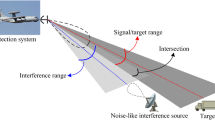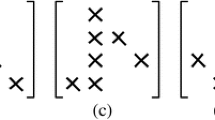Abstract
For the problem of detecting a distributed target using a subspace model, we examine one nonadaptive detector and three adaptive detectors. The nonadaptive detector was proposed under the assumption that the noise covariance matrix is known a priori, i.e., the detector is the asymptotic optimum detector (AOD). We derive the statistical distribution of the AOD, according to which we obtain analytical expressions for the probabilities of detection and false alarm. Many kinds of simulations are carried out, from which useful results are obtained.






Similar content being viewed by others
References
F. Bandiera, O. Besson, D. Orlando, G. Ricci, Theoretical performance analysis of the W-ABORT detector. IEEE Trans. Signal Process. 56(5), 2117–2121 (2008)
F. Bandiera, O. Besson, D. Orlando, G. Ricci, L.L. Scharf, GLRT-based direction detectors in homogeneous noise and subspace interference. IEEE Trans. Signal Process. 55(6), 2386–2394 (2007)
S. Chen, L. Kong, J. Yang, Target detection for heterogeneous cyclostationary sea clutter. Circuits Syst. Signal Process. 33(3), 959–971 (2014)
X. Chen, J. Guan, Y. Huang, N. Liu, Y. He, Radon-linear canonical ambiguity function-based detection and estimation method for marine target with micromotion. IEEE Trans. Geosci. Remote Sens. 53(4), 2225–2240 (2015)
D. Ciuonzo, A. De Maio, D. Orlando, A unifying framework for adaptive radar detection in homogeneous plus structured interference—part I: on the maximal invariant statistic. IEEE Trans. Signal Process. 64(11), 2894–2906 (2016)
D. Ciuonzo, A. De Maio, D. Orlando, A unifying framework for adaptive radar detection in homogeneous plus structured interference—part II: detectors design. IEEE Trans. Signal Process. 64(11), 2907–2919 (2016)
E. Conte, A. De Maio, G. Ricci, GLRT-based adaptive detection algorithms for range-spread targets. IEEE Trans. Signal Process. 49(7), 1336–1348 (2001)
G. Cui, L. Kong, X. Yang, Performance analysis of colocated MIMO radars with randomly distributed arrays in compound-Gaussian clutter. Circuits Syst. Signal Process. 31(4), 1407–1422 (2012)
G. Cui, L. Kong, X. Yang, GLRT-based detection algorithm for polarimetric MIMO radar against SIRV clutter. Circuits Syst. Signal Process. 31(3), 1033–1048 (2012)
A. De Maio, S.M. Kay, A. Farina, On the invariance, coincidence, and statistical equivalence of the GLRT, Rao test, and Wald test. IEEE Trans. Signal Process. 58(4), 1967–1979 (2010)
G.A. Fabrizio, A. Farina, M.D. Turley, Spatial adaptive subspace detection in OTH radar. IEEE Trans. Aerosp. Electron. Syst. 39(4), 1407–1428 (2003)
Y. Gao, H. Li, B. Himed, Knowledge-aided range-spread target detection for distributed MIMO radar in nonhomogeneous environments. IEEE Trans. Signal Process. 65(3), 617–627 (2017)
C. Hao, B. Liu, L. Cai, Performance analysis of a two-stage Rao detector. Sig. Process. 91(8), 2141–2146 (2011)
C. Hao, D. Orlando, G. Foglia, X. Ma, S. Yan, C. Hou, Persymmetric adaptive detection of distributed targets in partially-homogeneous environment. Digit. Signal Process. 24, 42–51 (2014)
C. Hao, D. Orlando, X. Ma, C. Hou, Persymmetric Rao and Wald tests for partially homogeneous environment. IEEE Signal Process. Lett. 19(9), 587–590 (2012)
C. Hao, D. Orlando, X. Ma, S. Yan, C. Hou, Persymmetric detectors with enhanced rejection capabilities. IET Radar Sonar Navig. 8(5), 557–563 (2014)
E.J. Kelly, K.M. Forsythe, Adaptive detection and parameter estimation for multidimensional signal models. Technical report, Lincoln Laboratory, Lexington (1989)
E.J. Kelly, An adaptive detection algorithm. IEEE Trans. Aerosp. Electron. Syst. 22(1), 115–127 (1986)
S. Kraut, L.L. Scharf, The CFAR adaptive subspace detector is a scale-invariant GLRT. IEEE Trans. Signal Process. 47(9), 2538–2541 (1999)
S. Kraut, L.L. Scharf, Adaptive subspace detectors. IEEE Trans. Signal Process. 49(1), 1–16 (2001)
J. Liu, G. Cui, H. Li, B. Himed, On the performance of a persymmetric adaptive matched filter. IEEE Trans. Aerosp. Electron. Syst. 51(4), 2605–2614 (2015)
J. Liu, W. Liu, B. Chen, H. Liu, H. Li, C. Hao, Modified Rao test for multichannel adaptive signal detection. IEEE Trans. Signal Process. 64(3), 714–725 (2016)
J. Liu, Z.-J. Zhang, Y. Yang, Optimal waveform design for generalized likelihood ratio and adaptive matched filter detectors using a diversely polarized antenna. Sig. Process. 92(4), 1126–1131 (2012)
J. Liu, Z.-J. Zhang, Y. Yang, H. Liu, A CFAR adaptive subspace detector for first-order or second-order Gaussian signals based on a single observation. IEEE Trans. Signal Process. 59(11), 5126–5140 (2011)
W. Liu, J. Liu, L. Huang, Z. Yang, H. Yang, Y.-L. Wang, Distributed target detectors with capabilities of mismatched subspace signal rejection. IEEE Trans. Aerosp. Electron. Syst. 53(2), 888–900 (2017)
W. Liu, Y. Wang, J. Liu, W. Xie, R. Li, H. Chen, Design and performance analysis of adaptive subspace detectors in orthogonal interference and Gaussian noise. IEEE Trans. Aerosp. Electron. Syst. 52(5), 2068–2079 (2016)
W. Liu, W. Xie, J. Liu, Y. Wang, Adaptive double subspace signal detection in Gaussian backgroundpart I: homogeneous environments. IEEE Trans. Signal Process. 62(9), 2345–2357 (2014)
W. Liu, W. Xie, J. Liu, Y. Wang, Adaptive double subspace signal detection in Gaussian backgroundpart II: partially homogeneous environments. IEEE Trans. Signal Process. 62(9), 2358–2369 (2014)
D. Orlando, G. Ricci, Adaptive radar detection and localization of a point-like target. IEEE Trans. Signal Process. 59(9), 4086–4096 (2011)
D. Pastina, P. Lombardo, T. Bucciarelli, Adaptive polarimetric target detection with coherent radar part I: detection against Gaussian background. IEEE Trans. Aerosp. Electron. Syst. 37(4), 1194–1206 (2001)
F.C. Robey, D.R. Fuhrmann, E.J. Kelly, R. Nitzberg, A CFAR adaptive matched filter detector. IEEE Trans. Aerosp. Electron. Syst. 28(1), 208–216 (1992)
D.A. Shnidman, The calculation of the probability of detection and the generalized marcum q-function. IEEE Trans. Inf. Theory 35(2), 389–400 (1989)
X. Shuai, L. Kong, J. Yang, Adaptive detection for distributed targets in Gaussian noise with Rao and Wald tests. Sci. China Inf. Sci. 55(6), 1290–1300 (2012)
J. Xu, X. Zhou, L.-C. Qian, X.-G. Xia, T. Long, Hybrid integration for highly maneuvering radar target detection based on generalized Radon-Fourier transform. IEEE Aerosp. Electron. Syst. Mag. 52(5), 2554–2561 (2016)
T. Zhang, G. Cui, L. Kong, X. Yang, Adaptive Bayesian detection using MIMO radar in spatially heterogeneous clutter. IEEE Signal Process. Lett. 20(6), 547–550 (2013)
J.-D. Zhu, J.-L. Li, X.-D. Gao, L.-B. Ye, H.-Y. Dai, Adaptive threshold detection and estimation of linear frequency-modulated continuous-wave signals based on periodic fractional Fourier transform. Circuits Syst. Signal Process. 35(7), 2502–2517 (2016)
Acknowledgements
This work was supported by the National Natural Science Foundation of China under Grant 61501505 and Natural Science Foundation of Hubei Province, China, under Grant 2017CFB589. We thank Glenn Pennycook, MSc, from Liwen Bianji, Edanz Group China (www.liwenbianji.cn/ac), for editing the English text of a draft of this manuscript.
Author information
Authors and Affiliations
Corresponding author
Rights and permissions
About this article
Cite this article
Li, H., Wang, H., Han, H. et al. Performance Analysis of Adaptive Detectors for a Distributed Target Based on Subspace Model. Circuits Syst Signal Process 37, 2651–2664 (2018). https://doi.org/10.1007/s00034-017-0688-1
Received:
Revised:
Accepted:
Published:
Issue Date:
DOI: https://doi.org/10.1007/s00034-017-0688-1




